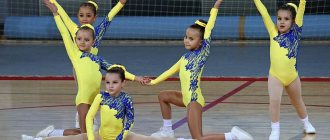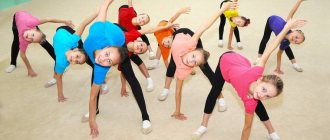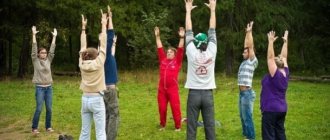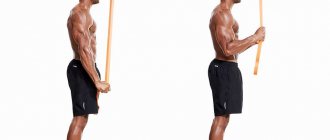Exercises for correct posture in children are a mandatory part of the health program
Pediatricians and orthopedists warn: children need to be provided with all the conditions for the correct formation of the spine.
You should take care of this from a very early age of the baby. To prevent spinal curvature and correct an existing problem, there are posture exercises for children. Along with doing it at home, you should take care of the child’s correct position at the table while eating, playing, etc.
Note! There is universal children's gymnastics for posture. This is a general therapeutic exercise developed by specialists in therapeutic and recreational physical education. It is necessary to prevent curvature of the spine and prevent diseases of the musculoskeletal system. Exercises that develop correct posture for children can be successfully done at home. They are useful for all children and serve as a simple, affordable, reliable means of prevention. During the classes, different muscle groups are used - neck, back, lower and upper extremities.
Physical therapy exercises for children with stooping
1. Tilts. For babies, you can pick up objects and place them in a container that the mother holds on top. Those. bent down, took it, straightened up, put it down. The specialist fixes the child with his back to himself, the baby’s legs are slightly bent at the knees, 5-10 degrees. Teenagers do this exercise without support, with their hands behind their heads, their back straight, their feet shoulder-width apart, while bending, look forward, without lowering the nose.
2. Lying on your stomach, raise and fix straight arms and legs in the following positions: arms back, to the sides, forward. Hold in each position for 10-30 seconds or more. The legs are raised so that the knees do not touch the floor.
3. Raises of the body, lying on the stomach, with fixed legs, touching the masseur’s hands with the shoulder blades. The specialist holds the shins with his second hand. The child's hands are locked behind his head. Hyperextension.
4. Sitting in the lotus position, the child’s hands are clasped above his head, palms up, forming a circle. In this position, the child turns right and left to the maximum without bending his back.
5. Standing on all fours, dive under a rope stretched across it at a height of 30 centimeters from the floor. The support points do not move during the exercise. The child stands so that his palms are slightly in front of the rope. Must dive, bending under the rope, ideally without touching either the rope or the floor, and raise the body on the other side with outstretched arms.
6. Squats with your back bent forward, hands behind your head, always look forward, maybe out the window.
With these exercises you can also do back riding with your legs clasped, a crampon, a bicycle, pumping your abs with bent legs or lifting straight legs, wheelbarrow, push-ups.
The number of repetitions is from 10 times or seconds, 2-3 are added every day.
Exercises to correct posture in children. When is a doctor needed?
In case of serious postural disorders, special physical therapy (PT) is indicated. Exercises for straightening posture for children are a special complex that is prescribed only by a doctor for medical reasons after an external examination of a small patient. When selecting exercises, a specialist takes into account the individual characteristics of the child’s body, the degree and nature of the curvature of the spine and many other nuances.
Causes of poor posture
Doctors identify the main factors that can lead to spinal curvature.
- Inactive lifestyle and physical activity. Muscles weaken due to prolonged sitting at a table, playing with a gadget, etc. Children of any age should move a lot, run, be in the fresh air for at least two hours a day and in any weather, play outdoor games. Ideally, a child should attend a sports section and exercise regularly under the guidance of a coach.
- Overload. Dosing physical activity and preventing injuries is a prerequisite for children’s health. Excessive exercise is no less dangerous for children than a sedentary lifestyle. If age standards regarding the duration of activities and their high intensity are not observed (for example, when preparing for sports competitions), the risks of injuries to the spine and muscles of the back, neck and shoulder girdle increase significantly. Wearing a heavy and non-ergonomic backpack also leads to poor posture.
- Bad habits. When reading or playing on a smartphone while lying down, drawing in an inappropriate position, etc., the spine gradually becomes deformed. It is necessary to teach your child to sit at the table correctly.
- Congenital pathologies of bone tissue. Doctors identify a special group of children with weakened back muscles and hereditary bone diseases. These children have a high risk of developing orthopedic diseases. For them, observation by an orthopedic doctor is mandatory. The specialist recommends a preventive or therapeutic set of exercises to strengthen posture for children at risk.
- Poor nutrition. An unbalanced daily menu becomes another factor that causes back curvature. Nutrition should include minerals, vitamins, proteins, fats and carbohydrates in the daily norms precisely indicated by doctors. In case of deficiency of useful elements necessary for the growth and development of bone and muscle tissue, the risks of scoliosis formation increase. This is especially true for preschool children.
- Poor workplace organization. Ergonomics is one of the most important points in a healthy posture program. If the workplace for games, meals and homework is poorly organized, curvature of the spine is inevitable even if all other doctor’s orders are followed. If a child walks a lot, eats right and even does posture exercises for children, but sits in the “wrong” chair, all the parents’ efforts are nullified.
| You can learn more about what doctors advise from this article. |
Improving a child's posture
To prevent poor posture, the child must be provided with acceptable conditions for sleep and leisure. The mattress should be firm enough so that the body takes an even position while sleeping, and the pillow should not be high. During games, it is best to sit on the floor. When playing at the table, the child will sit for a long time in one position, which does not help strengthen the spine.
A good solution for preventing correct posture would be to develop your back muscles through regular exercise in the form of play exercises. Some exercises can be put into practice at home, captivating the baby with new games.
Exercise games to prevent poor posture
When doing preventive exercises with your baby, you can imagine them in the form of exciting games, and he will be happy to do them regularly.
- "Giraffe". The exercise-game is aimed at strengthening muscles. You need to take your child’s favorite fruit and, having cut it not very finely, hang it on a string in such a way that the baby can reach the treat by stretching his neck strongly. After explaining to the child that giraffes are the longest-necked animals and showing pictures of them, you need to ask the child to take the treat with his lips the way a giraffe does. At the same time, you cannot take it with your hands (after all, a giraffe does not have them) and rise on your toes.
- "Trees in the forest." The exercise will help develop the muscles of the back and neck, as well as the arms and legs. During classes you will need several images with different trees. Each tree has a certain property that the child will need to depict. For example, oak. He is strong, stocky, strong, so the child stands up straight, arms down, body tense. The pine tree is tall, the branches are directed towards the sky - the baby reaches up and raises his straight arms above his head. And the willow leans towards the water, which means you need to relax and sway from side to side.
Morning work-out
The gymnastics game is aimed at general strengthening of the body and muscle development. The exercise also helps correct the spine. Charging consists of several exercises. Each is repeated 2-3 times.
- "Sun". The baby, while inhaling, describes a circle with his hands, lifts them up, stretches, and lowers them while exhaling.
- "Mill". The baby stands straight, with his feet shoulder-width apart, one arm extended above his head, tilted back, and the other down. Alternately changing hands, he depicts a mill.
- "Boat". The child should, lying on his stomach on a pre-prepared mat, stretch his arms forward. Raising his legs and arms slightly, he, swaying slightly, imitates a boat.
- "Turtle". Now you can just crawl on the carpet on your knees.
- "Heron". Here you will need a book and cubes. The baby will step over the toys laid out on the floor, holding a book on his head. The posture and steps should be like that of a heron, that is, you need to keep your back straight and raise your legs when stepping.
- "Cat" is one of the stretching exercises. The child should stand on all fours. Inhale - the baby arches his back and raises his head. Exhale – arches your back and lowers your head. The movements are smooth, like a cat's when it stretches.
- “Swallow” is an exercise that develops coordination of movements. An indispensable condition is a straight back when performing.
- “Caterpillar” or “Spring” is a relaxation exercise. The child lies on his back, raises his arms up and stretches, then relaxes his whole body and lies quietly for several minutes.
Good posture means good health
It is necessary to monitor your posture from a young age so that problems with the spine or internal organs do not arise later.
Therefore, it is very useful to conduct such training games with children regularly, each time coming up with something new, so that the child himself strives to complete the exercises. Let the child suggest what he would like to depict and demonstrate it. The main thing is to ensure that there are no excessive loads and actions that are dangerous for the fragile spine. Author: K.M.N., Academician of the Russian Academy of Medical Sciences M.A. Bobyr
“Growing” stool is the best prevention of scoliosis in children of any age
From the moment the baby begins to sit up on his own, he must have the “correct” chair. For such a product, it is possible to adjust the height of the back of the chair, its seat and footrest.
All parameters of the product adapted for children correspond to:
- growth;
- age;
- anatomical features of the child;
- safety requirements for children's furniture.
Regular chairs from the mass market and adult models are not suitable for children of all age groups. Such products do not have the required adjustments, do not provide correct posture, do not train the back muscles, do not teach the child to sit correctly from an early age and cannot be adjusted as the child grows. In addition, such models are made from cheap materials that are hazardous to health.
Therefore, the optimal solution for parents would be to purchase a certified “growing” chair from a reputable manufacturer.
Types of posture disorders in children
Pay attention to the different types of spinal deformities in children from 6 to 16 years old. They all have their own characteristics and severity.
- Lordosis.
- Kyphosis.
- Scoliosis.
- Torticollis.
In the presence of any of the listed conditions, the help of a specialist and the mandatory use of a treatment and prophylactic complex are required.
A set of posture exercises for children. Indications for general and special physical therapy
General physical therapy is carried out in the following cases:
- leg pain and muscle weakness;
- discomfort and pain in the back, neck, sacrum, coccyx;
- rapid fatigue from physical activity.
Videos and drawings
Preventive universal exercises for preschoolers and primary schoolchildren, an example version (see figure).











